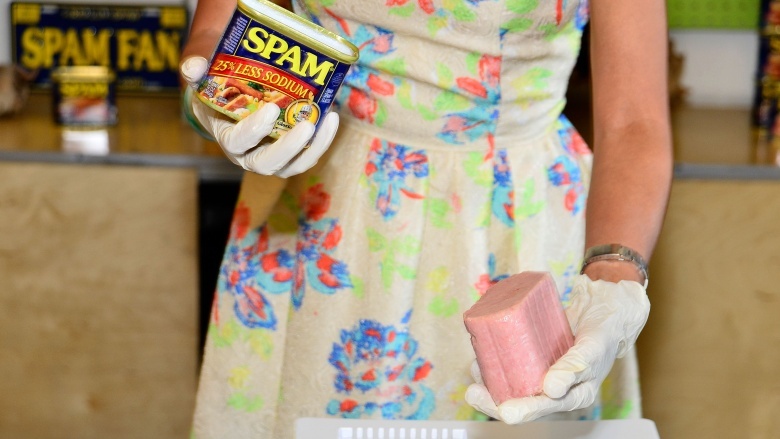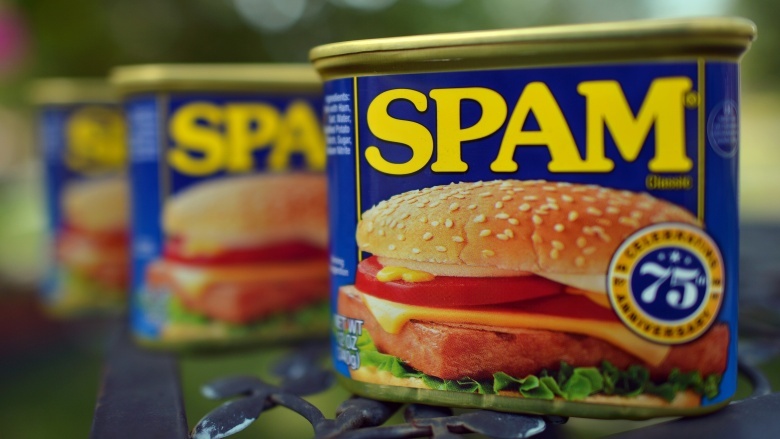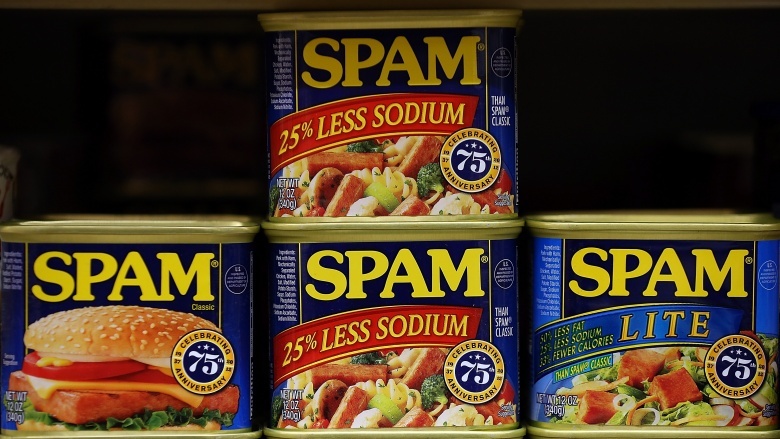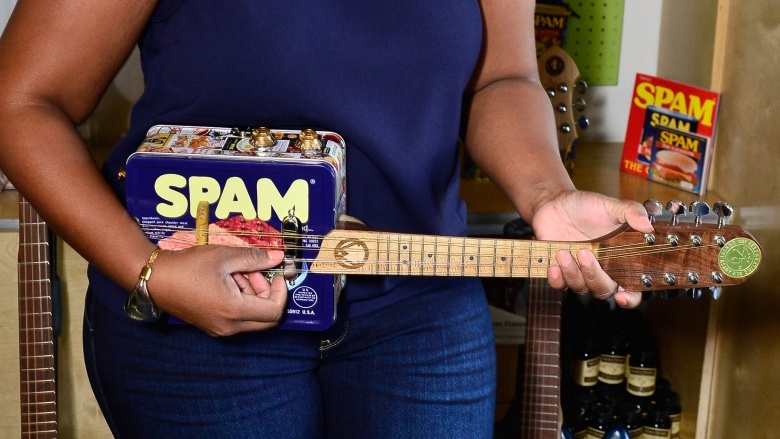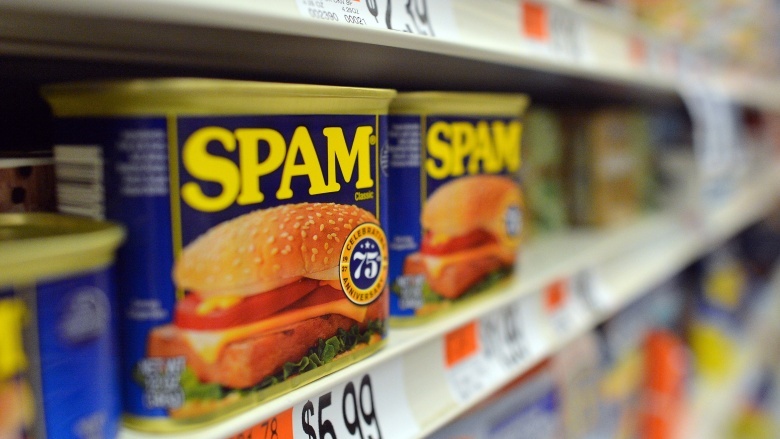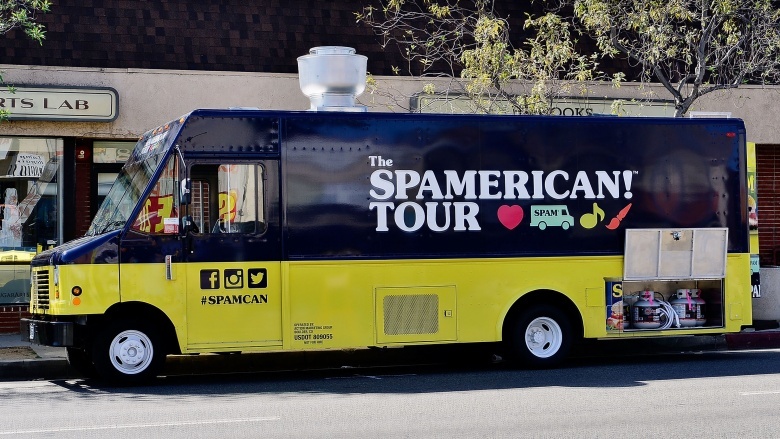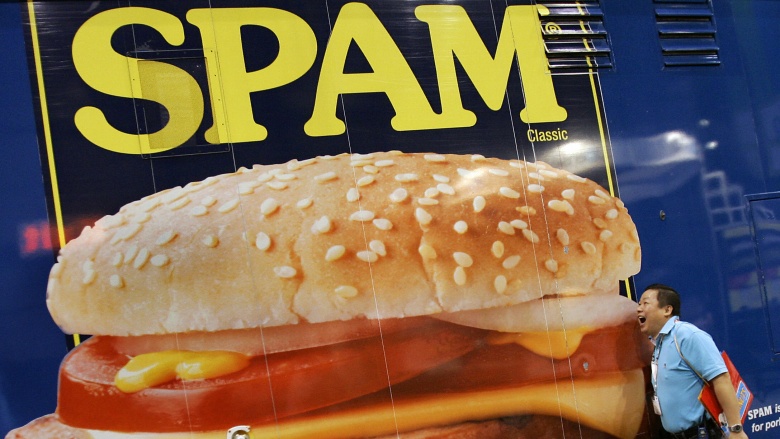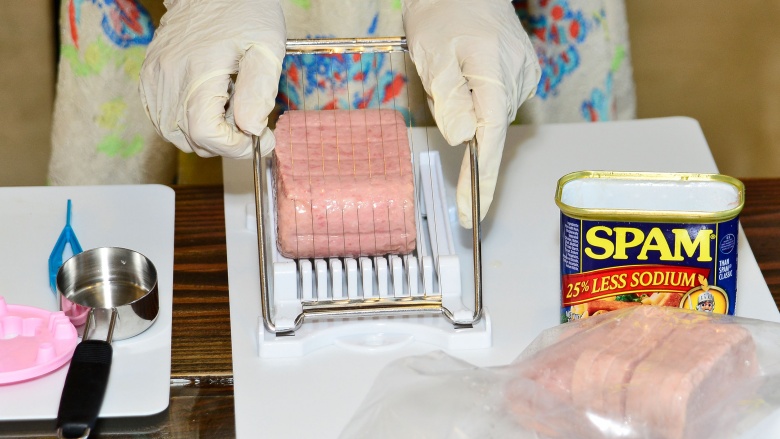The World's Secret Love Affair With Spam
Spam was created in 1937 by the Hormel Food Corporation. Simply put, it's a block of pink, processed meat in a squarish can—and in that state the meat will last a very long time, indeed. As a result, it has become heavily associated in the United States with poverty and bad taste...but it hasn't always been that way! Spam is so ubiquitous that it has become almost invisible, and while some people may describe it as boring, as you'll see, the reality is far weirder—and far more interesting—than you might think.
Spam isn't mystery meat at all
While it may be tempting to label Spam "mystery meat," that would actually be a mistake (and possibly libel). Hormel is actually very clear about what goes into their most popular meat brick: pork, salt, water, modified potato starch, sugar, and sodium nitrite. The potato starch is a relatively recent addition that prevents the meat from "sweating" inside the can (yum!), and the sodium nitrate is what gives the meat it's distinct pink tint (try saying that five times fast...). These ingredients are also often found in hot dogs, along with a lot of other stuff that you probably don't want to hear about before a baseball game. Spam: like hot dogs, but without the lips. Maybe they should put that on the can...
Nobody knows what "Spam" actually means
"SPAM" is more than just a catchy name for canned meat. It's also marketing genius. With the invention of that single word, Hormel managed to turn a simple dish into a memorable meat icon. But what does it even mean? An amalgamation of "spiced" and "ham" is a popular theory, as well as "shoulders of pork and ham." American G.I.s in World War II were known to refer to it as "ham that failed the physical," but the truth is that either nobody knows, or someone does, but they ain't telling. So it can mean whatever you want, like "Sunday's Perfect Afternoon Meal," or "Suspicious, Pink, And Meaty."
Some places see it as a delicacy
During and after the Second World War, Spam was an easy way to supply protein and calories to those in need, and that included a lot of people across Asia and the South Pacific. But unlike the American soldiers who made no effort to hide their distaste for the pink pig product, the residents of Hawaii, Guam, the Philippines, and the islands of Japan all liked it so much they immediately added Spam to their menus, where it has remained ever since. And unlike the United States, where Spam is seen as a last minute, out-of-ideas, cheap option, across the Pacific it's seen as a treat, and even a luxury. But perhaps for a nation that can make raw fish taste good, Spam is no challenge at all.
Hawaiit's annual Spam Jam festival
Hawaii is so in love with Spam that every year they hold a festival in its honor, called the Spam Jam. Attendees can taste a large variety of Spam dishes specially prepared by local restaurants, and even donate a can to a food bank. And should you be tempted to disregard this festival as a small affair, then take note: 25,000 people attended in 2015. This is actually not very surprising if you consider that Hawaii ranks number one on the list of Spam-consuming states, opening over 7 million cans each year. Even the Hawaiian branches of McDonalds and Burger King both include it on their menus, which probably makes Spam the least mysterious meat in the place.
There are many, many varieties of Spam
Original Spam in a can will turn 80 in 2017, and, like most octogenarians, it's picked up some family on the way. In fact, the Spam family now extends to 15 varieties, including Spam teriyaki, Spam Lite, Spam with cheese, Spam single, and the somewhat unsettling Spam spread. So no matter what your flavor, there's a Spam for you...unless you're vegetarian, in which case you'll have to wait for the release of veggie Spam...but don't hold your breath.
There are hundreds of official recipes involving Spam
It's easy to dismiss Spam as cheap and boring, especially when you consider its plain pink demeanor. But the reality is that there has never been an easier meal to make. And that's because Hormel makes it really easy for you by providing recipes on their website. And not just a few recipes, they have all the recipes. Okay, they have a few hundred, but that's still more than you were probably expecting.
And while it might be preferable to have fresh meat in your refrigerator, on the inevitable occasions when that doesn't happen, you'll be glad you had the Spam. But it's not just the contents that are versatile, because there are plenty of uses for a heavy square can...like a doorstop, or a paper weight, or a conversation starter...
Tens of thousands of cans of Spam gets made every hour
Spam might fly under the radar these days, but that doesn't mean no one eats it. In fact, the lack of attention it receives probably disguises its true popularity. According to some sources, 44,000 cans of Spam are produced every hour worldwide, and consumed in over 40 countries. Since Spam was first introduced in 1937, Hormel has made over 8 billion cans of the stuff...which is more than will fit into a convenient illustrative metaphor.
How much Spam gets eaten every year?
Hawaii might consume the most Spam per capita, but the rest of America isn't that far behind. Approximately 60 million people regularly eat Spam in the United States, and between them they eat 113 million cans every year. Now they may not actually be eating all of that. It could be being stored in anticipation of the zombie apocalypse, or the Yellowstone volcano. Come to think of it, maybe Hormel could sponsor a revival of that show Doomsday Preppers! Now that's corporate synergy...
Hormel used to make a song and dance about it
In 1946, Jay Hormel was on a committee tasked to find work for returning servicemen and women. He realized, fairly quickly, that women were having a harder time finding work than men — so, in a move that would simultaneously create jobs for women and help the family business, he created a musical marketing troupe called the Hormel Girls.
Dressed in pale green uniforms, and driving themselves around the country in a fleet of identical white Hormel-branded Chevys, the Hormel Girls performed and promoted Spam and other Hormel products to audiences at theaters and supermarkets around the country. At the height of their popularity, there were around 60 women employed by the troupe — they even had a hit radio program on three networks, making them effectively a live-action infomercial, which is slightly ironic since it was the birth of television advertising that put an end to them by the end of 1953.
Spam might be dismissed by many as a low-brow meal of last resort, but how many foods can claim not just a half-decent jingle, but an actual orchestra with a chorus line and dancers? Just Spam.
Spam even has its own museum
For many people, Spam is just a useful thing to keep around in case of a rainy (or apocalyptic) day. For some, however, that can of pink ham means so much more. What started out life as a practical, long-lasting alternative to fresh meat, has grown into a global cultural icon with legions of fans.
No cultural icon would be complete without a museum to tell the story, and Spam is no different. The Spam museum, located in Austin, Minnesota, offers Spam devotees a one-stop shop for Spam history, Spam facts, Spam memorabilia, and ... Spam. As of 2016, it has moved from its second home, where it had lived since 2002, into a brand-new, bigger building. Spam might fit in a small can, but its story needs a whole lot more room.
And speaking of that can ...
Hormel cooks their Spam right in the can
Spam is a bit like Superman, but not because it's in the habit of saving the innocent from danger (unless that danger is hunger of course). Rather, like Superman, Spam goes into a small space looking all soft and weak, but leaves it tough, dressed in primary colors, and ready for action.
In the case of Superman, that small space is usually a phone booth, but for Spam it's the can. That's because, instead of preparing and mixing the ingredients, cooking them, then wrapping them in metal, Hormel instead packages the ground pork and other ingredients while it's still raw and soft. Then after sealing, they heat the can to cook and sterilize. This allows them to fill the can all the way and limit wasted space, ensures the inside of the can is completely free of unwanted microscopic Spam fans, and prepares the outside for the iconic blue-and-yellow label that helps the wanted Spam fans find it on the shelf.
Is it a bird? Is it a plane? No, it's a Spam-wich!
